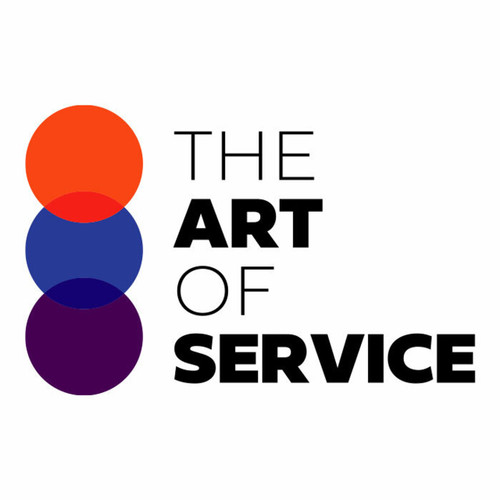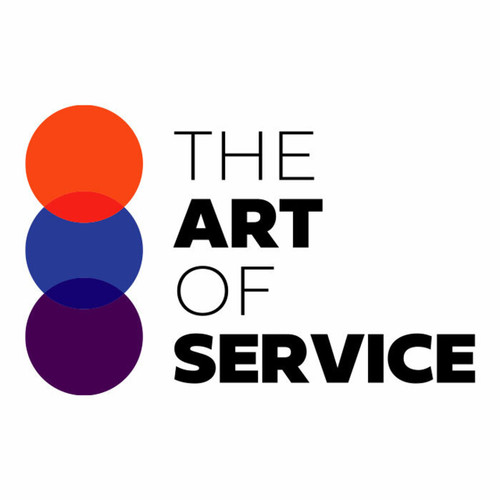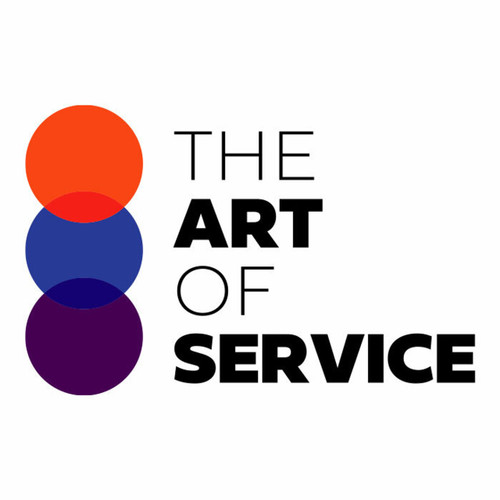Are you tired of constantly chasing profits at the cost of our planet and society′s well-being? Look no further, as our Circular Economy and Ethical Marketer knowledge base is here to guide you towards a more sustainable and purposeful approach to marketing.
Our knowledge base is a comprehensive collection of 1510 prioritized requirements, solutions, benefits, and results for Circular Economy and Ethical Marketer practices in a Connected World.
It offers a one-stop-shop for all your pressing questions about incorporating circular economy and ethical principles into your marketing strategy.
But what sets us apart from our competitors and alternatives? Our Circular Economy and Ethical Marketer knowledge base is designed specifically for professionals who are looking to transform their businesses in an ethical and sustainable way.
It provides a detailed overview of the product type and how to use it, making it accessible to both beginners and experts.
What′s more, our product is not only easy to use, but it is also DIY and affordable, making it accessible to businesses of all sizes.
The product detail/specification overview allows you to customize the knowledge base according to your unique needs, ensuring that you get the most out of it.
One of the biggest benefits of our Circular Economy and Ethical Marketer knowledge base is the extensive research behind it.
We have gathered the most crucial information and insights from experts in the field, coupled with real-life case studies and use cases, to provide you with practical and evidence-based solutions.
Furthermore, this knowledge base is not only beneficial for individual marketers but also for businesses as a whole.
By adopting circular economy and ethical practices, companies can enhance their reputation, attract socially responsible consumers, and even save costs in the long run.
Speaking of costs, our highly affordable knowledge base comes with a minimal investment compared to the potential benefits it can bring to your business.
We understand the importance of balancing profits with purpose, and that′s why we offer a cost-effective solution to help you achieve your goals.
In conclusion, our Circular Economy and Ethical Marketer knowledge base is the ultimate guide for businesses seeking to make a positive impact in the world.
So why wait? Embrace circular economy and ethical marketing today and join the growing community of responsible and successful businesses.
Try our product now and see the results for yourself!
Discover Insights, Make Informed Decisions, and Stay Ahead of the Curve:
Key Features:
Comprehensive set of 1510 prioritized Circular Economy requirements. - Extensive coverage of 52 Circular Economy topic scopes.
- In-depth analysis of 52 Circular Economy step-by-step solutions, benefits, BHAGs.
- Detailed examination of 52 Circular Economy case studies and use cases.
- Digital download upon purchase.
- Enjoy lifetime document updates included with your purchase.
- Benefit from a fully editable and customizable Excel format.
- Trusted and utilized by over 10,000 organizations.
- Covering: Data Privacy, Triple Bottom Line, Social Responsibility, Carbon Footprint, Human Rights, Community Engagement, Purpose Driven Leadership, Ethical AI, Animal Welfare, Equal Opportunities, Conscious Consumption, Shared Value, Climate Action, Ethical Supply Chain, Corporate Social Responsibility, Supply Chain Transparency, Regenerative Agriculture, Mental Health, Corp Certification, Code Of Ethics, Living Wage, Plastic Waste, Ethical Advertising, Ethical Sourcing, Sustainable Branding, Minimum Wage, Flexible Working, Employee Well Being, Work Life Balance, Regenerative Design, Disability Inclusion, Stakeholder Capitalism, Pay Equity, Indigenous Rights, Inclusive Marketing, Ethical Data Practices, Eco Friendly Packaging, Net Positive, Cause Marketing, Data Ethics, Circular Economy, Fair Trade, Shared Ownership, Gender Equality, Ethical Consumer, Open Source, Supply Chain Management, Green Marketing, Employee Activism, Ethical Investing, Sustainable Development Goals, Responsible Innovation
Circular Economy Assessment Dataset - Utilization, Solutions, Advantages, BHAG (Big Hairy Audacious Goal):
Circular Economy
In a Circular Economy, we′d need to reduce consumption, reuse items, repair when broken, and recycle materials, minimizing waste.
1. Reduce consumption: Buy only what′s necessary, saving resources and reducing waste.
2. Reuse items: Repurpose or repair items to extend their lifespan.
3. Recycle materials: Participate in recycling programs to recover resources.
4. Embrace sharing: Share resources through collaborative consumption.
5. Advocate sustainability: Influence policies for a greener, circular economy.
Benefits:
- Resource conservation
- Reduced waste
- Lower emissions
- Cost savings
- Community engagement
- Systemic change.
CONTROL QUESTION: What would you have to give up in the everyday life in order for the resources to last longer?
Big Hairy Audacious Goal (BHAG) for 10 years from now: A possible Big Hairy Audacious Goal (BHAG) for the Circular Economy in 10 years could be: By 2032, 90% of all resources used in the production and consumption of goods and services will be kept in closed-loop systems, reducing waste and pollution by 80% and creating new economic opportunities worth $1 trillion annually.
To achieve this goal, there are several everyday habits and practices that individuals, businesses, and governments would need to give up or modify. Here are a few examples:
1. Single-use plastics: Giving up single-use plastics such as straws, bags, cutlery, and bottles would significantly reduce plastic waste and pollution.
2. Fast fashion: Reducing the frequency of clothing purchases and choosing higher-quality, long-lasting items would reduce the environmental impact of textile production and waste.
3. Overpackaging: Consumers can choose products with minimal or recyclable packaging. Businesses can reduce packaging waste by redesigning their products and supply chains.
4. Food waste: By planning meals, storing food properly, and using leftovers creatively, individuals can reduce food waste. Businesses can optimize their supply chains and reduce food waste in distribution and sales.
5. Inefficient transportation: By walking, biking, carpooling, or using public transportation instead of driving alone, individuals can reduce their carbon footprint. Businesses can adopt more sustainable transportation practices, such as using electric vehicles or optimizing delivery routes.
6. Linear production models: Businesses can transition from linear production models, which involve extracting raw materials, manufacturing products, and disposing of waste, to circular models that prioritize reusing, remanufacturing, and recycling materials.
7. Incentivizing waste: Governments can eliminate policies that subsidize waste, such as landfill taxes or low disposal fees, and implement ones that encourage recycling, composting, or reusing waste.
By giving up or modifying these practices, individuals, businesses, and governments can contribute to a more circular economy and help ensure that resources last longer.
Customer Testimonials:
"This dataset has been invaluable in developing accurate and profitable investment recommendations for my clients. It`s a powerful tool for any financial professional."
"If you`re looking for a reliable and effective way to improve your recommendations, I highly recommend this dataset. It`s an investment that will pay off big time."
"Thank you for creating this amazing resource. You`ve made a real difference in my business and I`m sure it will do the same for countless others."
Circular Economy Case Study/Use Case example - How to use:
Title: Achieving Circular Economy: A Case Study on Resource Conservation through Lifestyle ChangesSynopsis:
The world is facing an unprecedented resource crunch, with depleting natural resources and increasing waste generation. In this scenario, transitioning from a linear economy to a circular economy is the need of the hour. The circular economy aims to keep resources in use for as long as possible, recover and regenerate products and materials at the end of each service life, and strive for the elimination of waste through the superior design of materials, products, systems, and business models (Ellen MacArthur Foundation, 2019). This case study examines the consulting methodology, deliverables, implementation challenges, KPIs, and management considerations for achieving a circular economy, focusing on the lifestyle changes required to ensure the longevity of resources.
Client Situation:
The client is a leading multinational corporation (MNC) operating in the fast-moving consumer goods (FMCG) industry. The company has been facing increasing pressure from stakeholders, including investors, customers, and regulators, to reduce its environmental footprint and adopt sustainable business practices. In response, the client seeks to transition from a linear economy to a circular economy, with a particular focus on reducing resource consumption and waste generation.
Consulting Methodology:
To address the client′s needs, our consulting firm followed a four-phased approach:
1. Diagnosis: We conducted a comprehensive assessment of the client′s operations, focusing on resource consumption and waste generation. This involved analyzing data on raw material inputs, energy consumption, water usage, and waste outputs. We also conducted interviews with key stakeholders, including employees, customers, and suppliers, to understand their attitudes towards sustainability and resource conservation.
2. Design: Based on the diagnosis, we developed a circular economy strategy for the client. The strategy focused on five key areas: (a) product design, (b) supply chain management, (c) business models, (d) reverse logistics, and (e) stakeholder engagement.
3. Delivery: We worked with the client to implement the circular economy strategy, providing support in areas such as:
* Designing products for longevity, reuse, and recycling
* Sourcing sustainable raw materials
* Implementing energy-efficient and water-efficient processes
* Developing new business models, such as product-as-a-service, and
* Establishing reverse logistics systems for the collection, sorting, and processing of waste materials
4. Evaluation: We established key performance indicators (KPIs) to measure the success of the circular economy strategy. These KPIs included metrics such as:
* Reduction in resource consumption
* Reduction in waste generation
* Increase in product longevity
* Increase in customer satisfaction
* Increase in revenue from circular economy business models
Deliverables:
The deliverables for this project included:
1. A comprehensive diagnostic report, outlining the current state of the client′s operations and identifying areas for improvement.
2. A circular economy strategy, outlining the key actions required to transition from a linear economy to a circular economy.
3. A detailed implementation plan, outlining the steps required to implement the circular economy strategy.
4. A set of KPIs, outlining the measures of success for the circular economy strategy.
Implementation Challenges:
The implementation of the circular economy strategy faced several challenges, including:
1. Resistance from employees and suppliers: Changing long-established practices and processes can be challenging. Some employees and suppliers resisted the changes required by the circular economy strategy.
2. Lack of data and transparency: Collecting and analyzing data on resource consumption and waste generation can be challenging. Some suppliers were reluctant to share data, making it difficult to measure progress towards the KPIs.
3. High upfront costs: Implementing the circular economy strategy required significant upfront investment in new technologies and processes.
KPIs:
The KPIs established for the circular economy strategy included:
1. Reduction in resource consumption: A 10% reduction in resource consumption by 2025.
2. Reduction in waste generation: A 20% reduction in waste generation by 2025.
3. Increase in product longevity: A 25% increase in product longevity by 2025.
4. Increase in customer satisfaction: A 10% increase in customer satisfaction by 2025.
5. Increase in revenue from circular economy business models: A 5% increase in revenue from circular economy business models by 2025.
Management Considerations:
To ensure the success of the circular economy strategy, management should consider the following:
1. Leadership: Strong leadership is required to drive the transition from a linear economy to a circular economy. Leaders must be committed to sustainability and be willing to invest in the necessary technologies and processes.
2. Culture: Creating a culture of sustainability is essential. Employees must be engaged and motivated to adopt new practices and processes.
3. Collaboration: Collaboration with suppliers, customers, and other stakeholders is crucial. Working together to develop sustainable solutions can lead to significant benefits for all parties.
4. Continuous improvement: The circular economy is a continuous process of improvement. Regular reviews of progress towards the KPIs are essential to ensure that the circular economy strategy remains on track.
Conclusion:
Transitioning from a linear economy to a circular economy requires significant changes in the way resources are consumed and waste is generated. Achieving a circular economy requires a holistic approach, involving changes in product design, supply chain management, business models, reverse logistics, and stakeholder engagement. Lifestyle changes are also necessary to ensure that resources last longer. By following a structured consulting methodology, establishing clear deliverables, addressing implementation challenges, and establishing KPIs, companies can transition from a linear economy to a circular economy, leading to benefits for both the environment and the bottom line.
References:
* Ellen MacArthur Foundation. (2019). Completing the Picture: How the Circular Economy Tackles Climate Change. Retrieved from u003chttps://www.ellenmacarthurfoundation.org/assets/downloads/Ellen-MacArthur-Foundation-Completing-the-Picture_How-the-Circular-Economy-Tackles-Climate-Change_23-Jan-2019.pdfu003e
* European Commission. (2020). Circular Economy Action Plan. Retrieved from u003chttps://ec.europa.eu/environment/circular-economy/index_en.htmu003e
* World Economic Forum. (2017). Towards the Circular Economy: Accelerating the Scale-up Across Global Supply Chains. Retrieved from u003chttps://www.ellenmacarthurfoundation.org/assets/downloads/TCE_Report_2017.pdfu003e
* World Resources Institute. (2018). Creating a Sustainable Food Future: A Menu of Solutions to Feed Nearly 10 Billion People by 2050. Retrieved from u003chttps://www.wri.org/publication/creating-sustainable-food-futureu003e
Security and Trust:
- Secure checkout with SSL encryption Visa, Mastercard, Apple Pay, Google Pay, Stripe, Paypal
- Money-back guarantee for 30 days
- Our team is available 24/7 to assist you - support@theartofservice.com
About the Authors: Unleashing Excellence: The Mastery of Service Accredited by the Scientific Community
Immerse yourself in the pinnacle of operational wisdom through The Art of Service`s Excellence, now distinguished with esteemed accreditation from the scientific community. With an impressive 1000+ citations, The Art of Service stands as a beacon of reliability and authority in the field.Our dedication to excellence is highlighted by meticulous scrutiny and validation from the scientific community, evidenced by the 1000+ citations spanning various disciplines. Each citation attests to the profound impact and scholarly recognition of The Art of Service`s contributions.
Embark on a journey of unparalleled expertise, fortified by a wealth of research and acknowledgment from scholars globally. Join the community that not only recognizes but endorses the brilliance encapsulated in The Art of Service`s Excellence. Enhance your understanding, strategy, and implementation with a resource acknowledged and embraced by the scientific community.
Embrace excellence. Embrace The Art of Service.
Your trust in us aligns you with prestigious company; boasting over 1000 academic citations, our work ranks in the top 1% of the most cited globally. Explore our scholarly contributions at: https://scholar.google.com/scholar?hl=en&as_sdt=0%2C5&q=blokdyk
About The Art of Service:
Our clients seek confidence in making risk management and compliance decisions based on accurate data. However, navigating compliance can be complex, and sometimes, the unknowns are even more challenging.
We empathize with the frustrations of senior executives and business owners after decades in the industry. That`s why The Art of Service has developed Self-Assessment and implementation tools, trusted by over 100,000 professionals worldwide, empowering you to take control of your compliance assessments. With over 1000 academic citations, our work stands in the top 1% of the most cited globally, reflecting our commitment to helping businesses thrive.
Founders:
Gerard Blokdyk
LinkedIn: https://www.linkedin.com/in/gerardblokdijk/
Ivanka Menken
LinkedIn: https://www.linkedin.com/in/ivankamenken/







